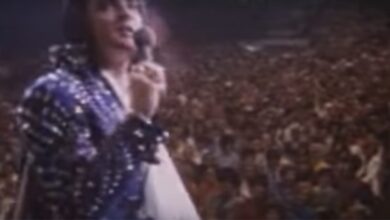The Performance Evokes Feelings Of Gratitude And Honor Among United States Veterans
Sgt. Barry Sadler’s “Ballad of the Green Berets,” a stirring tribute to the courage of U.S. Army Special Forces, emerged in 1966, a year marked by escalating tensions in Vietnam. The song, crafted during Sadler’s recovery from a serious combat injury, reflects both his personal experiences and the broader sentiments of a nation grappling with the complexities of war. As soldiers were faced with the challenges of combat in a foreign land, Sadler’s poignant lyrics offered a clarion call of valor, celebrating the dedication and sacrifice of those who served, particularly the Green Berets.
Sadler’s journey to becoming a soldier was shaped by a tumultuous childhood in Carlsbad, New Mexico. His parents’ divorce and the loss of his father at a young age left a profound impact on his life. To seek stability and purpose, he enlisted in the U.S. Air Force in 1958, eventually transitioning to the Army, where he joined the specialized Green Beret unit. This elite force is known not only for their combat prowess but also for their commitment to unconventional warfare, winning hearts and minds in addition to battling enemies on the ground.
While stationed in Vietnam, Sadler experienced the brutal realities of war, which left him with a severe leg wound during an ambush. This injury, however, became a catalyst for his creative expression, allowing him to channel his emotions and experiences into songwriting. “Ballad of the Green Berets” came to fruition as he lay recuperating, encapsulating the bond shared among soldiers and their unwavering spirit in the face of adversity. His lyrics offered a narrative steeped in pride, highlighting themes of bravery, heroism, and the undeniable sense of duty felt by those in uniform.
The song debuted amidst a climate where anti-war sentiments were surging, contrasting sharply with the feelings of pride and patriotism it evoked. Many Americans, struggling with the implications of the Vietnam War, found solace in Sadler’s tribute. “The Ballad of the Green Berets” resonated deeply, providing a voice to the often-unspoken respect for the sacrifices made by military personnel. This connection transcended boundaries, as the song was embraced not just in the United States but worldwide, reflecting a universal appreciation for soldiers who serve their countries.
With its tremendous success, the song ascended to number one on the Billboard Hot 100 chart, where it remained for five consecutive weeks in 1966. Its impact on American culture was profound, as it became a staple at military events and ceremonies, ensuring that the bravery of the Green Berets and other soldiers was honored and remembered within the national psyche. Beyond commercial success, the song inspired countless covers and adaptations, being translated into multiple languages and embraced by diverse audiences.
Despite the accolades and recognition that came from his musical success, Sadler’s life after the Army was marked by varying degrees of tumult and reinvention. He ventured into acting and writing, yet his later works could not replicate the iconic status of his famous song. Notably, he authored the “Casca” series, which centered on the life of a Roman soldier cursed with immortality. This series reflected Sadler’s fascination with themes of war and heroism, paralleling the sentiments expressed in his most famous work.
Tragedy struck in Sadler’s later years as he faced numerous personal challenges, including a controversial legal battle and a harrowing shooting incident in Guatemala that further complicated his life. These struggles brought a stark contrast to the heroic image that “The Ballad of the Green Berets” conveyed. The multifaceted nature of Sadler’s life, with its peaks of glory and valleys of hardship, paints a complex picture of a man forever linked to the ethos of military courage.
Barry Sadler’s passing in 1989 marked the end of an era for a soldier-turned-singer whose legacy remains intertwined with the message of his anthem. “Ballad of the Green Berets” continues to resonate, reminding listeners of the sacrifices made by those in uniform during a turbulent chapter of American history. Even decades later, the song is played at memorial services and events honoring veterans, preserving the memory of camaraderie forged in the crucible of war.
The enduring legacy of “The Ballad of the Green Berets” reconnects us to the sacrifices of those who served, promoting an understanding of both the trials and triumphs experienced by military personnel. Sadler’s narrative is more than a tribute to the Green Berets; it is a recognition of the collective spirit of all soldiers who place themselves in harm’s way. In recalling these histories, we gain insight into not only the past but also the value of honoring the narratives of those who have served, ensuring that their contributions are never forgotten.
Ultimately, Barry Sadler and his emblematic ballad stand testament to the power of art in reflecting the experiences of soldiers and the emotions of a nation. The song transcends its time, reinforcing the bonds of brotherhood among servicemen and women, while simultaneously inviting audiences to reflect on the deeper meanings of bravery, sacrifice, and remembrance in the face of war.
&ab_channel=WhenTheCowboySings





